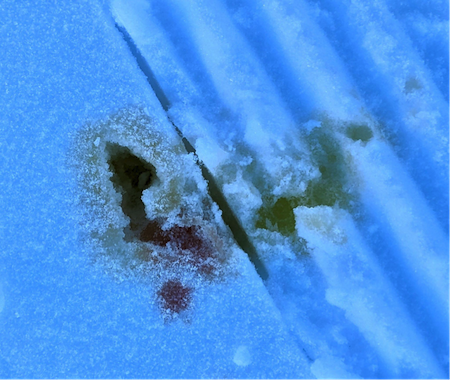BY LARRY BARNES
The darkness of winter is losing its grip. The day length through January increased by about one minute per day and February will average two minutes daily. By March, the light will gain three minutes each day. March 20th, the first day of spring, will be three hours longer than January 1st. And during these frozen months of comparative quietude, the land and its creatures are getting ready.
A coyote’s urine along a ski trail on January 11th included some blood, a fact obvious to those species having a good nose. But because the urine was on snow, it could also be detected by humans. The blood revealed a female coyote in proestrus, which lasts 5-9 days and all of the coyotes within her scentscape probably knew about it, especially the males. She will stop bleeding and be in estrus for another 5-9 days, during which time she will mate. Her pregnancy will carry her 60 days through to spring and her pups will be born into the season of long days and a land comparatively saturated in rising opportunity.
A nearby fresh deer kill, probably taken by a mountain lion, was likely why the coyote was on the ski trail in the first place. The lion was gone, perhaps watching its kill from a few hundred yards away, reclined comfortably and invisibly in the sagebrush steppe. The scent of a dead deer had summoned at least one local coyote who waited a safe distance until the lion’s belly was full. The coyote’s turn had begun in the night as the lion moved off and ended with the rising sun that would bring the danger of humans—the coyote’s bipedal, diurnal, superpredator.
The dawn light turned a streak of blood on the snow into a beacon for 25 magpies and 10 ravens that were there in line behind two golden eagles, all aiming to turn that deer into more magpies, ravens, and eagles.
The eagles flushed first, the sight of a two-legged at 250 yards being enough to signal that it was time to leave. One labored across my path with heavy wingbeats, its goiter-like crop laden with venison, and landed on the snowy hillside to catch its breath on this calm morning.
The eagles were possibly a local pair and at this time of year they might find themselves reconnoitering last year’s nest site, perching near it and sensing a nascent hormonal tug toward parenthood in 2023. As day length increases, certain sticks will strike their fancy and they will carry them to their nest, land there, and with care, close examination, and a tilting head, rearrange nesting material until it is just right to receive the annual symbol of immortality in the shape of eggs, usually two, in March.
The ravens were next in size and next in line at the kill, following life’s prime directives to obtain energy, stay alive, and make more ravens.
Here, in a country that freezes, the coming annual pulse of light will wake the land. The warmth will weaken the hydrogen bonds that have shackled life’s molecules during the frozen times. The light itself will turn trillions upon trillions of molecular cogs and levers to convert water and carbon dioxide into food for life, into more plants, coyotes, eagles, ravens, and magpies. But timing is critical and the window of opportunity short, and now is the time to get ready.
Larry Barnes retired from 26 years as a biology teacher at Wood River High School and is now transitioning to spending more time exploring the natural world.



